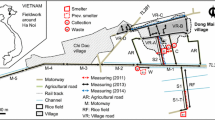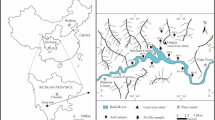Abstract
This study presents the distribution of blood lead levels and lead in various environmental samples (water, sediments, soils, and air) near the Shing-Yie storage battery recycling plant in Taiwan before (July 1990 to June 1991) and after (July 1992 to June 1993) amelioration. Before amelioration, the average blood lead levels in the neighborhood of the plant were in the range of 10.55±5.7 to 12.28±7.9 μg/dl. After amelioration, relatively lower average concentrations of blood lead (range 8.35±3.0 to 9.13±2.5 μg/dl) were generally found; however, these averages were still higher than that (7.79±3.5 μg/dl) from other lead-unpolluted areas of Taiwan. An exceedingly high geometric mean (GM) lead concentration (128 μg/L) was found in the downstream river water of the Tawulum River passing by the plant. The concentrations of lead (GM=372 and 418 μg/g) in the downstream river sediments were higher than those (GM=123 and 158 μg/g) in the upstream river sediments before and after amelioration, respectively. Furthermore, lead species in river sediments were analyzed by a sequential leaching technique. The sum of phases I, II, and III accounted for 83.7% of total lead at station R2 (nearest to the plant). Maximum lead concentration (GM=2402 μg/g) in dust at the soil surface from station S1 (nearest to the plant) was much higher than those from the other stations by about 18 times before amelioration. However, the maximum value dropped to 1,155 μg/g after amelioration. On the whole, the geometric mean concentration of lead in dust at the soil surface nearest to the plant was >1,000 μg/g and decreased to <100 μg/g in the 15–30 cm depth soil about 2 km away from the plant. Before amelioration, the geometric mean lead concentration of 4.57 μg/m3 (range 0.102–37.6 μg/m3) in the air near the plant was higher than that at the background locations, the geometric mean value of which was 0.08 μg/m3.
Similar content being viewed by others
References
Berode M, Wietlisbach V, Rickenbach M, Guillemin MP (1991) Life-style and environmental factors as determinants of blood lead levels in a Swiss population. Environ Res 55:1–17
Bryan GW, Langston WJ, Hummerstone LG, Burt GR (1985) A guide of the assessment of heavy-metal contamination in estuaries using biological indicators. Mar Biol Ass UK, Plymouth, Devon, UK, Occasional Publication No. 4
Chi YM, Chen SL, Yang MH, Hwang RC, Chu ML (1993) Heavy metals in traditional Chinese medicine: Ba-pao-neu-hwang-san. Acta Paedi Sinica 34:181–190
Ducoffre G, Claeys F, Bruaux P (1990) Lowering time trend of blood lead levels in Belgium since 1978. Environ Res 51:25–34
Francek MA, Makimaa B, Pan V, Hanko JH (1994) Small town lead levels: A case study from the homes of pre-schoolers in Mt. Pleasant, Michigan. Environ Pollut 84:159–166
Greene T, Ernhart CB, Boyd TA (1992) Contributions of risk factors to elevated blood dentine lead levels in preschool children. Sci Total Environ 115:239–260
Gunn AM, Winnard DA, Hunt DTE (1991) Trace metal speciation in sediments and soils. In: Kramer JR, Allen HE (eds) Metal speciation theory, analysis, and application. Lewis Publishers, pp 261–294
Han BC, Chiou HI, Yeh CY, Hsu TJ (1991) The epidemiological study on environmental lead contamination near a battery recycling plant (I). Technical Report (EPA-80-F102–09–42), 102 p, Environmental Potection Administration, Taipei, Taiwan, ROC
Han BC, Chen RY, Yeh CY, Hsu TJ (1993) The epidemiological study on environmental lead contamination near a battery recycling plant (II). Technical Report (EPA-82-F102–09–42), 102 p, Environmental Protection Administration, Taipei, Taiwan, ROC
Han BC, Chen RY, Chiou HI, Yeh CY, Hsu TJ (1994a) Distribution of lead pollution in soil and air around a storage battery recycling plant. J Natl Public Health Assoc (ROC) 13:126–137
Han BC, Jeng WL, Jeng MS, Hung TC (1994b) Copper intake and health threat by consuming seafood from copper contaminated coastal environments in Taiwan. Environ Toxicol Chem 13:775–780
Han BC, Chiou HI, Chen RY, Yeh CY, Hung TC (1992a) Speciation of lead pollution in water and sediments around a battery recycling plant. J Chin Environ Prot Soc 15:64–74
Han BC, Jeng WL, Hung TC (1992b) Assessment of copper complexing capacity in sediments. J Chin Inst Environ Eng 2:255–262
Huel G, Boudene C, Jouan M, Lazar P (1986) Assessment of exposure to lead of the general population in the French community through biological monitoring. Int Arch Occup Environ Health 58:131–139
Jang CS (1989) Study of lead recycling factory's occupational and environmental disease (in Chinese). Master's Thesis, National Taiwan University, Department of Public Health, Taipei, Taiwan, ROC
Jeng WL, Han BC (1994) Sedimentary coprostanol in Kaohsiung Harbour and the Tan-Shui estuary, Taiwan. Mar Pollut Bull 28:494–499
Mielke HW (1991) Lead in residential soils: Background and preliminary results of New Orleans. Water Air Soil Pollut 57–58:111–119
— (1992) Lead dust contaminated U.S.A. communities: Comparison of Louisiana and Minnesota. Appl Geochem 6:1–5
Needleman HL, Schell A, Bellinger D, Leviton A, Allred EN (1990) The long-term effects of exposure to low doses of lead in childhood: An 11-year follow-up report. N Engl J Med 332:83–88
Quinn MJ, Delves HT (1987) UK blood lead monitoring programme 1984–1987: Protocol and result for 1984. Human Toxicol 6:459–474
Rabinowitz M, Wang JD, Soong WT (1991) Dentine lead and child intelligence in Taiwan. Arch Environ Health 46:351–360
— (1992) Children's classroom behavior and lead in Taiwan. Bull Environ Contam Toxicol 48:282–288
Thomton I, Davies DJA, Watt JM, Quinn MJ (1990) Lead exposure in young children from dust and soil in the United Kingdom. Environ Health Persp 89:55–60
Wang JD, Jang CS, Hwang YH, Chen ZS (1992) Lead contamination around a kindergarten near a battery recycling plant. Bull Environ Contam Toxicol 49:23–30
Author information
Authors and Affiliations
Rights and permissions
About this article
Cite this article
Yeh, C.Y., Chiou, H.Y., Chen, R.Y. et al. Monitoring lead pollution near a storage battery recycling plant in Taiwan, Republic of China. Arch. Environ. Contam. Toxicol. 30, 227–234 (1996). https://doi.org/10.1007/BF00215802
Received:
Revised:
Issue Date:
DOI: https://doi.org/10.1007/BF00215802




